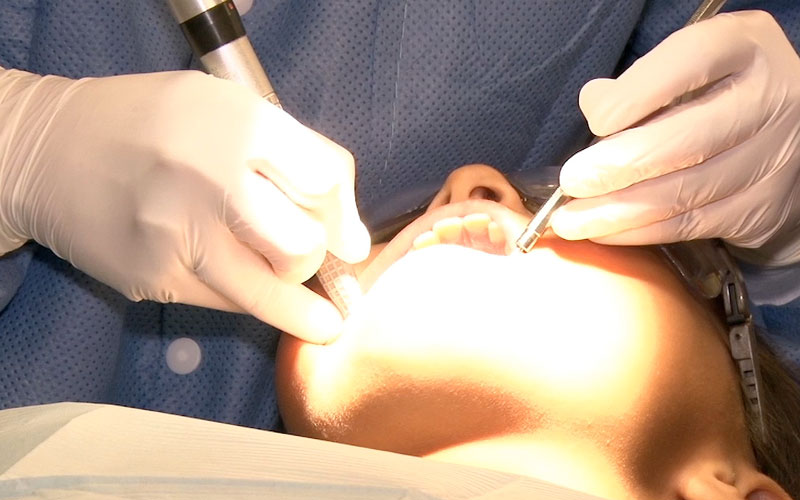
A dentist applies dental sealants to a child’s molars at Native Health in Phoenix. (Photo by Alisha Liyanage/Cronkite News)
At Native Health in central Phoenix, dentist Anh Thu Becker uses a 3-D model of molars to explain how she’s going to apply a thin layer of plastic resin to 10-year-old Suzette’s teeth.
With dental sealant on her molars, Suzette – Cronkite News agreed to use only her first name because she’s a minor – is far less likely to get cavities over the next five years.
On average, dental sealants cost about $48. Most private insurance plans cover the entire cost. The state’s Medicaid system will reimburse $25 of that cost, and parents who make too much to qualify for Medicaid but too little to afford insurance face paying in full or going without.
Native Health provides sealants for Suzette and other children at no cost.
A report card this year by the Pew Charitable Trusts gives Arizona a C-minus for its efforts to help children from low-income families get dental sealants. That grade was an improvement from the previous report card, which gave Arizona a D.
The report card faults Arizona in two areas:
• Not providing dental sealant programs at 75 percent or more of schools with significant percentages of children receiving free or reduced-price lunch;
• And not having half of all children receive dental sealants by sixth grade.
Arizona’s grade improved because of a new law allowing dental hygienists to apply sealants without a dentist’s review. The previous report card, for 2012, identified that as a major obstacle in providing dental sealants through school programs.
“We know that that step, which experience and research tells us does not need to happen, is also costly,” said Jane Koppelman, Pew’s research director for children’s dental policy. “It takes a lot of time, and fewer kids get served.”
The report card credits Arizona for submitting data to the National Oral Health Surveillance System maintained by the Centers for Disease Control and Prevention.
Koppelman said children from low-income families need dental sealants the most.
“They’re the kids who are more likely to have tooth decay and less likely to see a dentist,” she said.
Koppelman said there are other barriers to getting dental-sealant programs into schools, including funding.
“Even if there is money, policymakers have to convince principals to let these programs into their schools,” she said.
Julia Wacloff, chief of the Arizona Department of Health Services’ Office of Oral Health, said she hopes to see Arizona’s grade continue to improve.
“Our local county health departments and community health centers work very closely with the schools, engaging them and really establishing that close relationship to help them increase their awareness and also feel comfortable with providers coming into the school to provide those sealants,” she said.
The state’s sealant programs operate on approximately $450,000, coming from the Maternal and Child Health Block Grant program, the State Oral Health Fund and donations from groups including Delta Dental, Wacloff said.
Sandi Perez, communication and community outreach vice president for the Delta Dental of Arizona Foundation, the insurer’s charitable arm, said Common Core standards have burdened schools so much so that administrators are hesitant to let programs into the school day.
“Oftentimes, people don’t understand that if you have a toothache it’s really hard to learn, it’s really hard to pay attention,” she said. “I think that’s part of what we need to not just educate parents about but also school nurses, schoolteachers and maybe administrators and principals as well.”
Once programs have made their way into a school, then parents become the next obstacle, Perez said. Parents must sign waivers for their children to receive the sealants, and sometimes that is confusing and scary for parents, she said.
“They feel they might take on some financial burden that they didn’t anticipate or they’re not familiar with the program,” Perez said.
The Delta Dental of Arizona Foundation provides grants to Native Health and similar organizations that provide dental care to children in need.
Koppelman from Pew said sealants now can save children and their families from painful and costly procedures later.
“Sealants can prevent 80 percent of decay in a child for up to five years, that kind of result is stunning,” she said. “The cost of the intervention is quite low, and the amount of time that it takes to do the procedure is quite low, sealant programs really are more bang for your buck.”